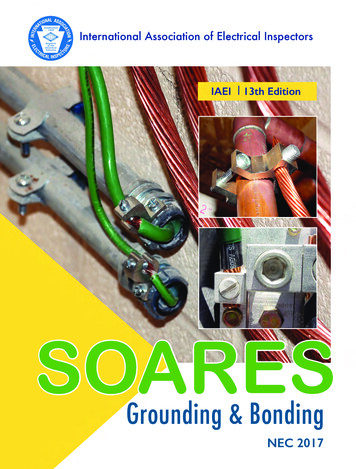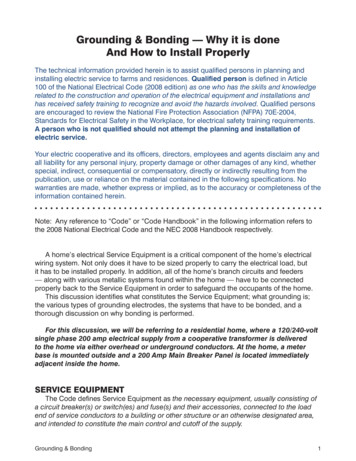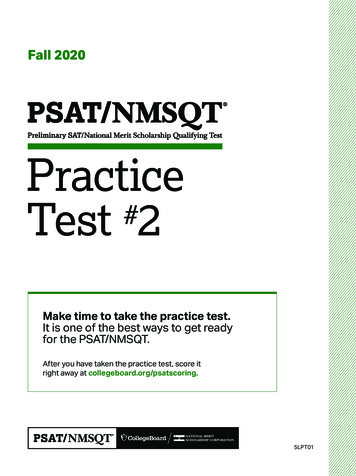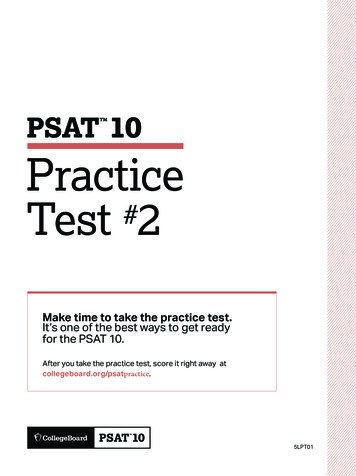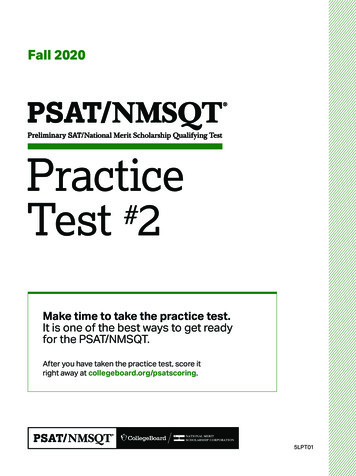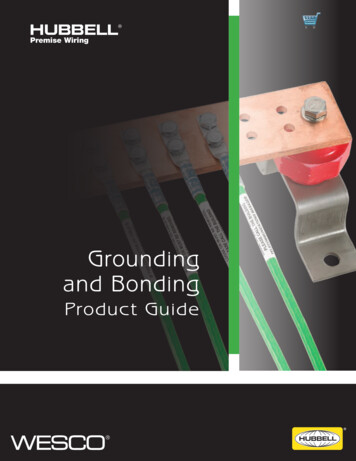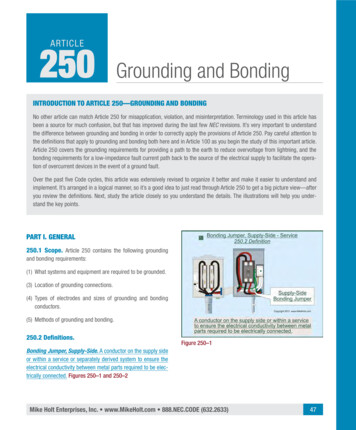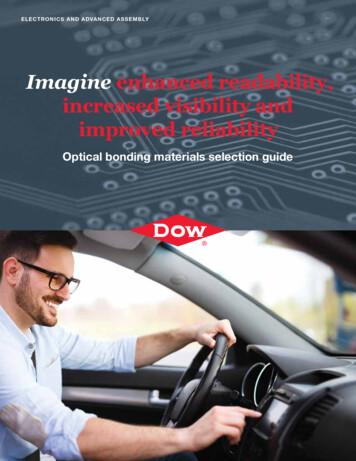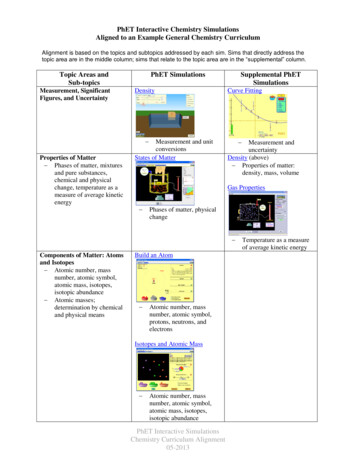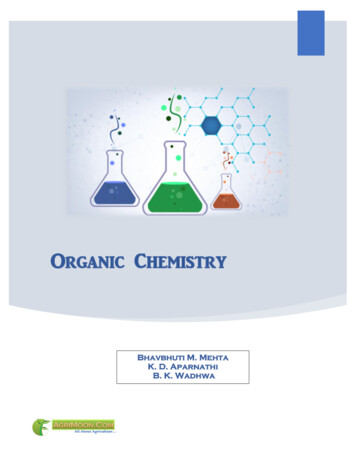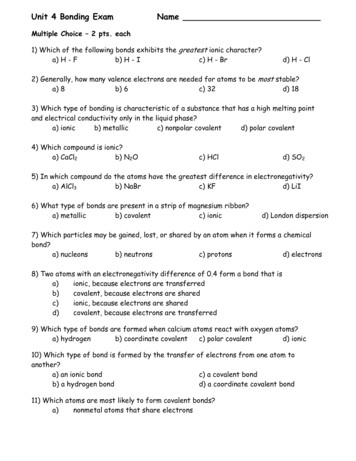
Transcription
Unit 4 Bonding ExamNameMultiple Choice – 2 pts. each1) Which of the following bonds exhibits the greatest ionic character?a) H - Fb) H - Ic) H - Brd) H - Cl2) Generally, how many valence electrons are needed for atoms to be most stable?a) 8b) 6c) 32d) 183) Which type of bonding is characteristic of a substance that has a high melting pointand electrical conductivity only in the liquid phase?a) ionicb) metallicc) nonpolar covalentd) polar covalent4) Which compound is ionic?b) N2Oa) CaCl2c) HCld) SO25) In which compound do the atoms have the greatest difference in electronegativity?a) AlCl3b) NaBrc) KFd) LiI6) What type of bonds are present in a strip of magnesium ribbon?a) metallicb) covalentc) ionicd) London dispersion7) Which particles may be gained, lost, or shared by an atom when it forms a chemicalbond?a) nucleonsb) neutronsc) protonsd) electrons8) Two atoms with an electronegativity difference of 0.4 form a bond that isa)ionic, because electrons are transferredb)covalent, because electrons are sharedc)ionic, because electrons are sharedd)covalent, because electrons are transferred9) Which type of bonds are formed when calcium atoms react with oxygen atoms?a) hydrogenb) coordinate covalentc) polar covalentd) ionic10) Which type of bond is formed by the transfer of electrons from one atom toanother?a) an ionic bondc) a covalent bondb) a hydrogen bondd) a coordinate covalent bond11) Which atoms are most likely to form covalent bonds?a)nonmetal atoms that share electrons
b)metal atoms that share protonsc)nonmetal atoms that share protonsd)metal atoms that share electrons12) Which compound contains both covalent and ionic bonds?a) CCl4b) KClc) MgCl2d) NH4Cl13) Oxygen, nitrogen, and fluorine bond with hydrogen to form molecules. Thesemolecules are attracted to each other bya) coordinate covalent bondsc) ionic bondsb) electrovalent bondsd) hydrogen bonds14) The bond between hydrogen and oxygen in a water molecule is classified asa) covalent and nonpolarc) ionic and polarb) ionic and nonpolard) covalent and polar15) Which is a nonpolar molecule containing a nonpolar covalent bond?b) CO2c) NH3a) I2d) H2O16) Which diagram best represents a polar covalent molecule?a)b)HClc)NaCld)Cl2H217) Which molecule is nonpolar due to a symmetrical distribution of charge?a) CO2b) NH 3c) HCld) H2O18) The unusually high boiling point of water is due to thea)network bonds between the moleculesb)nonpolar character of the moleculesc)hydrogen bonds between the moleculesd)linear structure of the molecules19) Which substance will conduct electricity in both the solid phase and the liquid phase?a) AgClb) HClc) Agd) H220) Which formula represents a molecular substance?a) Al2O3b) CO21) Which molecule contains a polar covalent bond?c) CaOd) Li2O
a):NΞN:b)c)H―Hd)22) The electrons in a bond between two iodine atoms (I2) are shareda) unequally, and the resulting bond is polarb) equally, and the resulting bond is polarc) unequally, and the resulting bond is nonpolard) equally, and the resulting bond is nonpolar23) Which of the following solid substances contains positive ions immersed in a sea ofmobile electrons?a) O2b) Cuc) CuOd) SiO2Short Answer Questions:24) In the boxes below, draw a correct Lewis electron-dot structure for: (3 pts.)(1)an atom of hydrogen(2)an atom of oxygen(3)a molecule of water (H2O)(1) hydrogen25)H ---- ClBond A(2) oxygen(3) waterBr ---- BrBond Ba) State one way in which bond A and bond B (above) are the same andone way in which they are different. (2 pts.)b) Draw the Lewis electron-dot diagrams for the two molecules above.Label any partial charges. (2 pts.)
HClBr2c) Is HCl a polar or nonpolar molecule? [Explain why.](2 pts.)26) Write the correct IUPAC chemical formula for the following compounds (1 pt. each)1) barium chloride2) iron (III) bromide3) dihydrogen monoxide4) magnesium nitrate5) sodium bromide27) Write the correct IUPAC chemical names for the following compounds (1 pt. each)1) CF42) N2S33) MgO4) NaOH28) Metals like copper are often used in electrical wiring.a) Name two properties of metals that makes them useful in electrical wiring (2 pts.)b) Explain how metallic bonding between copper atoms can account for each ofthese properties (1 pt.)29) Describe the role of valence electrons in:(1 pt. each)
1) an ionic bond2) a covalent bond3) a metallic bond30) In the laboratory, a student compares the properties of two unknown solids.The results of his experiment are reported in the data table below.Melting PointSolubility in WaterHardnessElectrical ConductivitySubstance Alownearly insolublesoft, waxy crystalspoor conductor in bothsolid and aqueous statesSubstance Bhighsolublehard crystalspoor conductor in thesolid state, but goodconductor in theaqueous statePredict the type of bonding in substance A. (1 pt.)31) Given the binary compound formed from magnesium and chlorine:a) Write the correct IUPAC name for this compound (1 pt.)b) Write the correct chemical formula for this compound (1 pt.)c) What type of bond forms between magnesium and chlorine? [Give onereason to support your answer.] (2 pts.)d) In the boxes below, draw the Lewis electron-dot structures for theelements Mg and Cl. (2 pts.)
magnesiumchlorinee) In the box below, draw the Lewis electron-dot structure for thecompound formed from magnesium and chlorine. [Include any charges orpartial charges.] (1 pt.)32) Explain, in terms of electronegativity, why an H-F bond is expected to be morepolar than an H-I bond. (2 pts.)BONUS Questions – 1 pt. each33) Given the reaction:H2 Cl2 2HClWhich statement best describes the energy change as bonds are formed andbroken in this reaction?a)The forming of the H-Cl bond releases energyb)The forming of the H-Cl bond absorbs energyc)The breaking of the H-H bond releases energyd)The breaking of the Cl-Cl bond releases energy34) When phosphorus and chlorine atoms combine to form a molecule of PCl3, 6 electronswill bea) shared equallyb) shared unequallyc) lostd) gained
35) In the box below, draw a Lewis electron-dot structure for a molecule of hydrogen.hydrogen
REGENTS CHEMISTRYMr. Dolgos1.Bonding & Naming Practice .17.18.19.20.21.22.23.
REGENTS CHEMISTRYMr. DolgosBonding & Naming Practice TestNamePeriod
REGENTS CHEMISTRYMr. DolgosBonding & Naming Practice TestNamePeriod
REGENTS CHEMISTRYMr. DolgosBonding & Naming Practice TestNamePeriod
Dec 12, 2017 · 1) an ionic bond 2) a covalent bond 3) a metallic bond 30) In the laboratory, a student compares the properties of two unknown solids. The result

